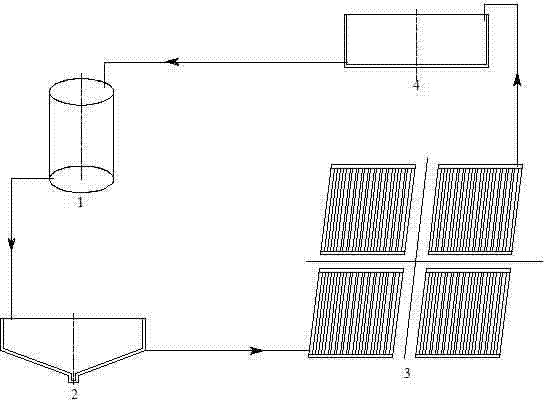Method for treating and reusing Haematococcus pluvialis large-scale culture wastewater
A technology for Haematococcus pluvialis and aquaculture wastewater is applied in the field of Haematococcus pluvialis large-scale aquaculture wastewater treatment and reuse, and wastewater treatment and reuse fields, and can solve the problem of no method for treating and recycling Haematococcus pluvialis aquaculture wastewater. and installations, so as to alleviate the shortage of water resources, eliminate growth inhibitors, and save energy.
- Summary
- Abstract
- Description
- Claims
- Application Information
AI Technical Summary
Problems solved by technology
Method used
Image
Examples
Embodiment 1
[0028] In summer (July), in the Shandong area, the Haematococcus pluvialis in the later stage of large-scale cultivation will be cultivated in the photobioreactor 1 in a water body of 10m 3 , into the built 15m 3 In the sedimentation tank 2. After settling for 24 hours, the supernatant in the sedimentation tank 2 was observed under a microscope. When the algae cells were not visible in the field of vision, the supernatant water in the sedimentation tank 2 was pumped into the large solar water heater device 3, and the water temperature at this time was measured. is 25°C. Under sunny conditions, after 8 hours of heating, the water temperature in the large-scale solar water heater device 3 reaches above 95° C. After maintaining for 1 hour, the water body is discharged and enters the cooling pool 4 for natural cooling. When the temperature of the water body in the cooling pool 4 is measured to be 25°C, the water body is re-entered into the photobioreactor 1 for cultivating Haema...
Embodiment 2
[0033] In winter (December), in the Shandong area, adopt the same method as in summer, and the Haematococcus pluvialis in the late stage of large-scale cultivation in photobioreactor 1 will be cultured in a water body of 10m 3 , into the built 15m 3 In the sedimentation tank 2. After settling for 24 hours, the supernatant in the sedimentation tank 2 was observed under a microscope. When the algae cells were not visible in the field of vision, the supernatant water in the sedimentation tank 2 was pumped into the large-scale solar water heater device 3, and at the same time, the The water temperature is 25°C. Under sunny conditions, after 8 hours of heating, the water temperature in the large-scale solar water heater device 3 reaches above 80°C. After maintaining for 1 hour, the water body is discharged and enters the cooling pool 4 for natural cooling. When the water temperature is measured to be 25°C, put the water body back into the photobioreactor 1 for cultivating Haemato...
PUM
 Login to View More
Login to View More Abstract
Description
Claims
Application Information
 Login to View More
Login to View More - R&D
- Intellectual Property
- Life Sciences
- Materials
- Tech Scout
- Unparalleled Data Quality
- Higher Quality Content
- 60% Fewer Hallucinations
Browse by: Latest US Patents, China's latest patents, Technical Efficacy Thesaurus, Application Domain, Technology Topic, Popular Technical Reports.
© 2025 PatSnap. All rights reserved.Legal|Privacy policy|Modern Slavery Act Transparency Statement|Sitemap|About US| Contact US: help@patsnap.com

